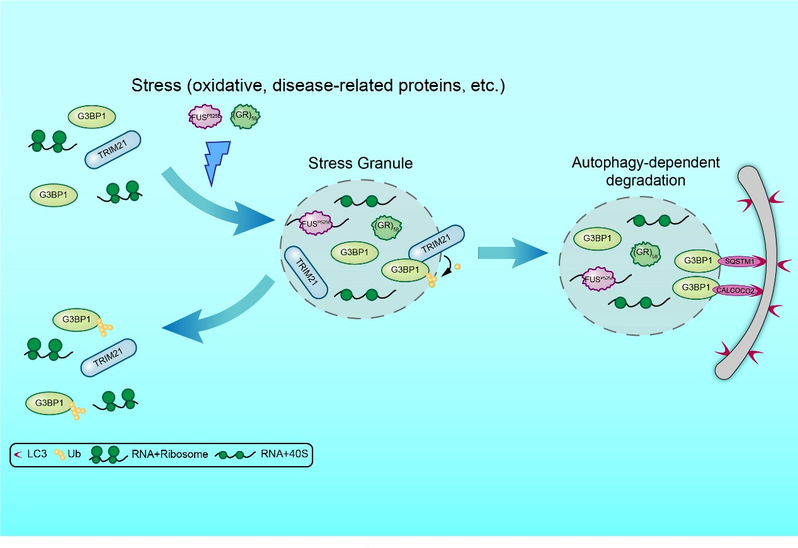On January 24th, 2023, a research article entitled “Stress granule homeostasis is modulated by TRIM21-mediated ubiquitination of G3BP1 and autophagy-dependent elimination of stress granules” was published online in the journal Autophagy. This work was completed by groups of Professors Yanfen Liu and Yun Bai from the School of Life Science and Technology (SLST) at ShanghaiTech University.
Stress granules are membraneless condensates of RNA and RNA-binding proteins formed in response to cell stress. The new evidence of the relationship between stress granules and neurodegenerative diseases highlights their physiological importance. Therefore, understanding the mechanism of this association and determining the key players that control stress granule homeostasis are crucial to the development of treatment methods for these diseases.
The prevalence of several quality control proteins in stress granules indicates that the compartment has been strictly monitored. Liu’s group screened six E3 ligases that exist in stress granules, and identified TRIM21 (tripartite motif containing 21) as the central regulator of stress granule homeostasis, which is highly enriched in stress granules under oxidative stress.
TRIM21 has previously been reported to participate in the ubiquitin-mediated autophagic degradation of a couple of innate immune responsive effectors. Liu’s group finds that TRIM21 mediates lysine 63-linked ubiquitination of the stress granule core protein G3BP1, which subsequently inhibits stress granule formation. On the contrary, TRIM21 knockdown leads to a decrease in the level of ubiquitin binding to G3BP1and promotes the formation of stress granules.
In addition, researchers find that stress granule homeostasis is also regulated by autophagy. Autophagy is a highly conserved intracellular pathway involved in the disposal of protein aggregates, damaged organelles and invaded pathogens through lysosomal degradation. This study provides evidence for SQSTM1 and CALCOCO2 being the primary autophagy receptors in autophagic clearance of physiological and pathological stress granules.
This study was supported by the National Natural Science Foundation of China and the Start-up grants from ShanghaiTech University.

Model of TRIM21 and autophagy machinery in regulating the homeostasis of stress granules.
Link: https://www.tandfonline.com/doi/full/10.1080/15548627.2022.2164427
This news article is provided by Professor Yanfen Liu.


